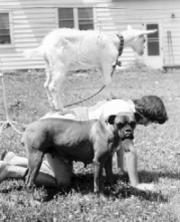The headline of the Empty Nest Newsletter for Vol 10 #3, January 1992, reads:
LE GUIN COMING TO BELOIT!
WILL TEACH 6 WEEKS; PUBLIC READING MARCH 26, CHAPEL 8 PM
There follows a picture:

The article follows, that Ursula Le Guin will be a “Mackey Scholar”—Beloit’s most prestigious visiting honor. “Thirty students have applied to be in her advanced writing class; fifteen have been chosen...”
Beloit, both town and college, was of major interest to me and my newsletter readership. I had graduated from Beloit, and had grown up on a dairy farm east of town, where my father, a Beloit grad himself, still lived. My youngest daughter Elspeth, herself with a Beloit MAT, was living with her grandfather while teaching at an area school.
My Empty Nest Newsletter was a sporadic “journal” begun when that last child had left for college in the east. It was a way to keep in touch with family now spread out. The circulation started small and gradually grew to almost two hundred, as many others wanted to read what I considered “news.” This issue, Volume 10, no. 3, showed my excitement about Le Guin’s upcoming residency at my home college. I was then a professor at the University of Illinois-Springfield where I taught certain of Le Guin’s books every semester: the Earthsea books in my children’s lit classes, and The Left Hand of Darkness in my sci-fi and fantasy classes. Each time I taught these books I reread them so that I knew them practically by heart: they never lost their immediacy, their effect on me. I kept finding new and deeper meanings, insights, and relevancies.
Le Guin’s work penetrated my house, as well as myself and my classes: I had an Earthsea bathroom, the walls mapped with the islands of Earthsea. You could lie in the tub and from your navel view Havnor, the navel of Earthsea’s world. Selidor, its farthest shore, was over your left shoulder under the light switch. Also I had almost all of Le Guin’s many books loaned out to my students. And now—I was going to meet her! For I had every intention of driving north to Beloit for her major public lecture.
The Empty Nest issue continued with a passage from the author Tove Jansson. My own kids grew up with Jansson’s Moomintroll books, and named our pets after Moomintroll creatures. Snufkin, a major character, is taking a needed moment alone, when a small creature, a “creep” in Moomintroll parlance, comes close and says, “May I warm myself by your fire?” He then prattles on and on, how everyone admires Snufkin, how much he admires Snufkin, how he is now really free, because his hero has asked his name! At length Snufkin sighs and puts down his harmonica. “You can’t ever be really free,” he tells the creature, “if you admire somebody too much.” “I know,” says the creep, yet proceeds to enlarge his adoration.
“So,” my newsletter article continues, “I will sit at Ursula Le Guin’s campfire, O Best Beloveds, and listen to her tune, and hope to be less apparent in my adoration than the little creep!” I then tell those that don’t already know, certain facts about Le Guin. That she won the National Book Award for The Farthest Shore. And, that she is the much-honored author of more than 15 novels, 60 short stories, poetry (including chapbooks and three collections), seven books for children, criticism (including two collections), and screenplays. I continue with more, not her full oeuvre of course, because I am writing in 1992.
A subsequent issue of the Newsletter has this headline:
WOODEN WOMAN MEETS LE GUIN!
OR, LE GUIN MEETS WOODEN WOMAN? ANYWAY, THERE’S A MUTUAL MEETING
There follows an account of the visit, but it begins with this preamble:
“As you readers know from a previous issue, Le Guin was coming to teach at Beloit for six weeks, and the Empty Nest editor was looking forward to hearing her read in person, and meeting her. Also, most of you family members are familiar with the wooden stick figure that Grampa had on the porch for how many years? Standing there in the corner with an old hat on its head. Over five feet tall, arms and legs, all one stick. Rather remarkable, if a bit ungainly in stance. Well, it occurred to me on one of my drives between Springfield and Beloit that this natural and intriguing figure might give Le Guin a smile if it were greeting her when she got to the college guest house. So on my arrival at the farm I brought the stick inside the front hall, dusted off the cobwebs, dressed it—now a 'her'—in a straw hat with red ties, a little blue gingham dress that Mom had worn the year she spent in bed in the living room, and a basket of bright plastic flowers in one hand, a sign in the other saying 'Welcome Ursula Le Guin.' Ellie, watching the proceedings from a perch on the front stairs, remarked that the unique thing about the stick was that it was all ONE stick, yet with the dress on it, one could no longer tell. So I draped the dress from her shoulders as a gingham cape, and that exposed the splendid wooden body again. Since I couldn’t be in Beloit on Le Guin’s arrival date, Ellie agreed to place the figure at the guest house for me, and she did.”
Several weeks later, I made a quick trip to Beloit and was surprised to see the wooden woman back at the farm. Ellie explained that hardly had the stick departed before Grampa began agitating. Would she be safe? Someone might steal her! I’d wondered about this myself, but I figured it was a chance worth taking, and a worthy end for the stick, if she did come to grief. Besides, a number of my Beloit faculty friends knew of her origin. Such was Ellie’s grandfather’s unexpected concern for his stick that after a week or so she had fetched her home again. I figured the welcomer had accomplished her mission and was going to let it go at that. But I confided to my friend Tom McBride, head of the English Department, why the wooden woman had disappeared. He said, “Ursula likes that stick woman. I was with her when she’d fallen over, and she picked her up and steadied her with considerable concern. I think you should bring her back.”
Well! At that I decided to carry the fun a little further. So I selected another of Mother’s “hospital” dresses, a different bonnet (lavender rafia that a plant had come in) and a different bunch of bright plastic flowers for the basket. As you know, at the farm you can find anything on the back stairs and in the back room. Those failing, there’s always the attic and basement. No sign needed this time, and I carried her down at midnight, and tried to get her to stand against the oak tree where Ellie’d propped her before. She wouldn’t stay up. Luckily, I had a jump rope in my car. (doesn’t everybody?) and it was just long enough to fit around the tree. I took a few pictures of her, to show Grandpa how she looked in situ.
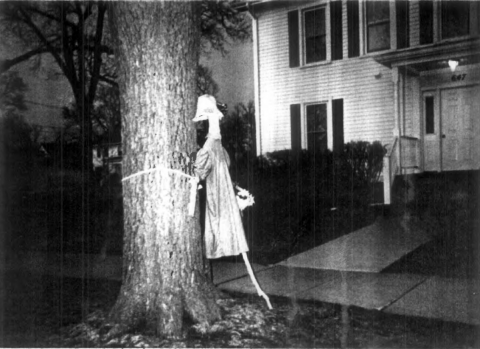
A week later was Le Guin’s public reading. I brought up three students from the many who were eager to hear her, and the stick woman was still standing serenely against the tree. The reading came, the chapel was full, Tom McBride gave a fine introduction of the speaker, and then Le Guin began. “Beloit College has given me an office, and a computer, and plenty of time,” she said, “and so I have been writing poetry. I’m going to start by reading some of the poems I’ve written while I’ve been here.” The first was to her predecessor in the Mackey Chair, William Stafford. At its conclusion, she looked down, looked up and read the title of the next poem: “Wooden Woman.” I was of course shocked, but a delighted shock, and Tom and I caught each other’s eyes as she read the poem.
The Wooden Woman
The long-limbed lady leans against
Her mother in an easy attitude,
A snow frill on her straw bonnet
And a gingham ruffle to keep out the cold.People passing turn around,
And mutter, and go on.
With strangers
She is polite, but stiff.One day she’d fallen over.
I helped her up.
“A little too much rhubarb wine,” she whispered.The day before the Equinox she dropped
Her basket of plastic flowers.
“Spring,” she said, “has come!”
It snowed next morning.Last thing at night I look down and see her
Calmly lurching through the dark to tell me
That, strange as it may seem, I’m home.Gone! Off on her broomstick!
O these flighty girls.
I am bereft,
And her oakmama stands there, arms uplifted,
In an imprecation of squirrels.She’s back again, my switch witch,
With new flowers, new hat, new purple dress.
In a fit of the creeping giggles,
She’s tied herself to mama’s apron strings.
As Le Guin finished, she looked around the audience, “Nobody’s been able to tell me where the Wooden Woman has come from. I certainly hope that by the time I leave I will have found out.” She then continued with more poetry, a prose selection, and the final section—comments on a women’s language in China that was dying out.
There followed a reception. Near its close, Tom told me it was time for me to meet Le Guin, and also, he thought, to tell her about the source of the Wooden Woman. He’d make the introduction. I had been wavering about the anonymity, after her saying she wanted to know, so agreed. Tom said to her, “If the oak tree is the mother of the Wooden Woman, then this is her other mother.” Le Guin looked puzzled from him to me and back again, and he repeated it. At that point her face broke into smiles, and she clasped my hand, and from then on we were friends. She said the woman had actually fallen down frequently, so the rope was a good idea, and that her new dress was “spiffy.”
A number of days after the reading, Le Guin broke her stay at Beloit to go to New York to receive some big honor. I’d figured that after reading, I’d take the stick, dress her in some “farewell” sort of garb (none of Mother’s Goodwill remaining frocks came up to the “spiffy” one), and have Ellie put her back for Le Guin’s return and final stay. But it seemed wrong to snatch her away the very night she had been publicly recognized, so I asked Ellie not to bring her home until after Le Guin had left for New York. Then I went from Springfield to Beloit again over Easter, and dressed the woman in my old high-school formal “daisy dress,” still in the farm’s attic dress-up-clothes box. It was made of light green cotton piqué with white daisies, very simple, but my kids thought it an old tablecloth. I added a broad hat of Mom’s that wasn’t good enough to worry about it being rained on or lost, and I switched the flowers in the basket to daisies. I was set to replace her against the tree, except it was midnight and pouring rain. “She’ll be a sodden mess by morning,” my audience, Ellie, commented from her stair step. So I returned her to her tree around 7:00 on Easter morn; all was quiet, but it turned out the Le Guins were up and took pictures through the blinds, unbeknownst to me.
After Le Guin’s return to Oregon, she sent me those pictures and more, plus the “Wooden Woman” poem written out in her handwriting, now including these last four lines:
Gone again, and how I missed her,
My loving little wooden sister!
“She’ll come back,” the oak tree whispered.
And she did, with the bells at Easter.
She signed her letter, “For Jacqueline Jackson, with love from Ursula.” She also added that these poems now belonged to me, and that if she chose to publish them, she would ask my permission.
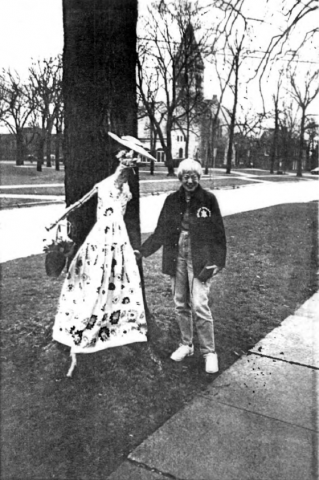
I thanked her and sent her a response, from the Wooden Woman:
Well, my moment of unexpected glory is over.
I’m back home.
But I have been admired,
Wondered about (“who can she be?”),
Had my picture taken,
Even had a poem written to me
By the one I’d gone to honor
The honor returned.
And the reception at home!
I didn’t know that I was valued
Until I disappeared.
They’d got so used to me,
There in my apron and straw bonnet,
Weeding the garden, hanging out the clothes.
Now—
Now, they’re looking at me with some kind of awe.
Some kind of—well, perplexity.
“Have we ever really known her?”
“After all—what might she do next?”
I had one more meeting with Le Guin before her departure. There was to be a final reception and I again traveled north to Beloit for this. I expected a chance to talk; I had many things I longed to talk about with her. I came with multiple copies of a map of all the islands of Earthsea, titled “Which Three are Named after the Le Guin Children?” But the farewell crowd was large and she was surrounded. Her husband was not. I stood with him, showed him the map, and indicated the two islands I could identify. He pointed to a third, and explained, “When our youngest was small, he couldn’t pronounce his older sister’s name; this is what he’d say, ‘Taon,’ instead of ‘Caroline.’”
At length a space opened before the guest of honor and I slid into it. She recognized me. I said, “We are the same age.”
She nodded.
“We read the same magazines when we were kids,” I said, “The Saturday Review.”
“The Saturday Evening Post,” she said.
I said, “Yes, but also our folks took The Saturday Review.”
She nodded.
I said, “When we were twelve or thirteen, they were publishing in every issue, a brief column by a celebrity as to what that person considered the most beautiful word or phrase in the English language.”
She nodded again.
I said, “Franklin P. Adams in his column said he considered the most beautiful words were cellar door.” (He would have pronounced them with his New England accent, dropping the ‘r’: they would have sounded like cellah door.)
Le Guin looked me in my eyes and said, “There is not one person in a million in this world that could have said that to me.”
I expected then that we would begin to talk on other things, both personal and literary. But the president of the college suddenly swept her up, and he and his wife bore the Le Guins off to a farewell supper. The reception was over.
In my Fantasy and Sci Fi classes, even in my Children’s Lit, I always gave each student a departing sheet. It was encircled with elvish runes and listed, with some explanation, the five most fantastic things about our inexplicable existence. The first being that there is any “being” at all. And after these five things, I then added these words from Le Guin’s A Wizard of Earthsea, where the wizard, soon to relinquish his power to young Prince Arren when they arrive at Selidor, the farthest shore, says, “… this is. And thou art. There is no safety and there is no end. The word must be heard in silence: there must be darkness to see the stars. The dance is always danced above the hollow place, above the terrible abyss.”
I then said to my students, and now to any reader, O Best Beloveds, “May we all, with joy and wonder and faith, continue to dance the Great Mysteries, above the Unfathomable Abyss!”
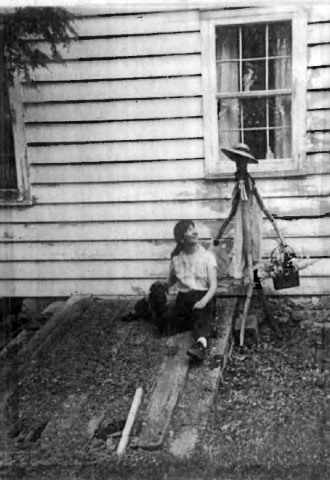
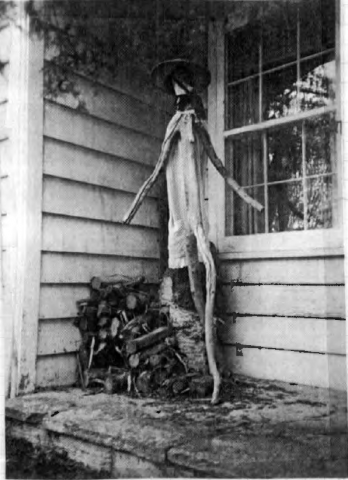
Photo: Jacqueline Dougan Jackson's daughter, Damaris, on the cellar door.
Sincere thanks to Theodore Le Guin, son of Ursula Le Guin, for his warm support.


